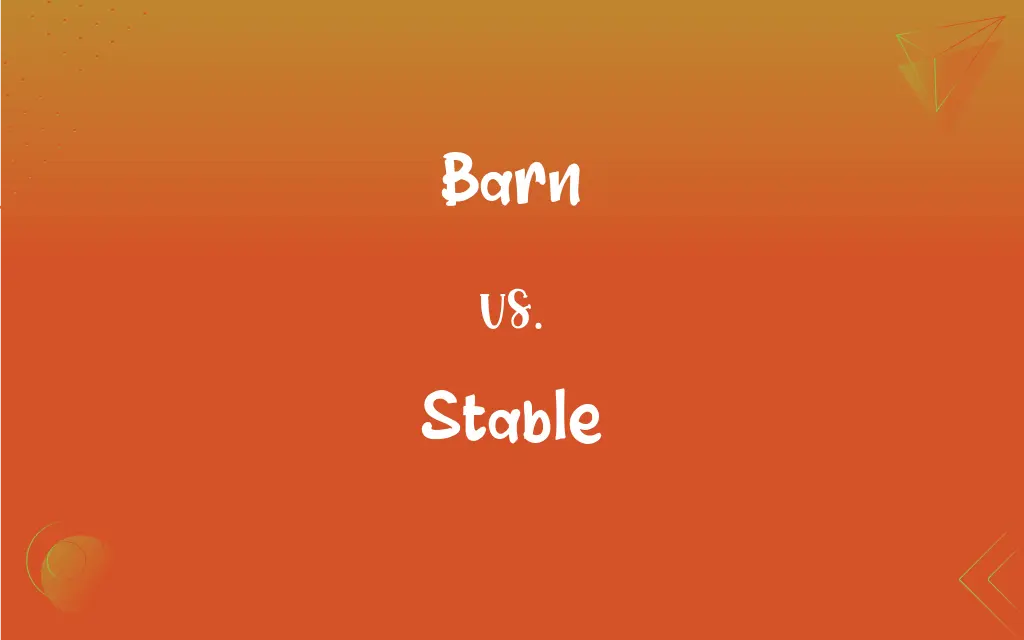Barn vs. Stable: What's the Difference?
By Aimie Carlson & Janet White || Updated on May 22, 2024
A barn is a large farm building used for storing hay, grain, and housing livestock, whereas a stable is specifically designed for housing horses and other equines.

Key Differences
A barn is primarily a multi-purpose farm building used for storage and housing livestock. It often includes space for hay, grain, and equipment, making it a central structure on many farms. On the other hand, a stable is a specific type of building designed to house horses and other equines. Stables are usually divided into individual stalls to accommodate each animal separately.
Barns are generally larger and more versatile, often accommodating different types of animals and a variety of farming needs. They can store tools, machinery, and harvests, whereas stables are typically smaller and more specialized. Stables focus on providing a suitable environment for equines, with features like tack rooms and grooming areas.
The design of a barn is often more open to facilitate ventilation and storage, whereas stables are designed with the comfort and safety of horses in mind. Stables have specific features such as individual stalls, proper drainage, and sometimes climate control to maintain a healthy environment for the horses.
In terms of location, barns are commonly found on diverse types of farms and ranches, while stables are predominantly associated with facilities dedicated to equestrian activities. This distinction highlights the different purposes each structure serves within the agricultural and equestrian communities.
Comparison Chart
Primary Use
Storage and housing for various livestock
Housing for horses and equines
ADVERTISEMENT
Structure Size
Generally larger and multi-purpose
Typically smaller and specialized
Design Focus
Ventilation and storage capacity
Comfort and safety for horses
Common Location
Diverse farms and ranches
Equestrian facilities and farms
Internal Features
Open spaces, storage areas
Individual stalls, tack rooms
Barn and Stable Definitions
Barn
A place for storing farm machinery.
The tractor is kept in the barn.
ADVERTISEMENT
Stable
Resistant to change of position or condition; not easily moved or disturbed
A house built on stable ground.
A stable platform.
Barn
A large farm building used for storing hay and grain.
The farmer stored his tools and equipment in the barn.
Stable
Not subject to sudden or extreme change or fluctuation
A stable economy.
A stable currency.
Barn
A building often made of wood, with wide, open spaces.
The old barn had a rustic charm with its weathered wood.
Stable
Maintaining equilibrium; self-restoring
A stable aircraft.
Barn
A large building for sheltering livestock, storing hay or other agricultural products, or housing equipment used for operating a farm.
Stable
Enduring or permanent
A stable peace.
Barn
A large shed for the housing of vehicles, such as railroad cars.
Stable
Consistent or dependable
She has been stable in her support for the project.
Barn
A particularly large, typically bare building
Lived in a barn of a country house.
Stable
Not showing or marked by erratic or volatile emotions or behavior
He remained stable even after he lost his job.
Barn
Abbr. b(Physics) A unit of area equal to 10-24 square centimeters, used to measure cross sections in nuclear physics.
Stable
(Physics) Having no known mode of decay; indefinitely long-lived. Used of atomic particles.
Barn
(agriculture) A building, often found on a farm, used for storage or keeping animals such as cattle.
Stable
(Chemistry) Not easily decomposed or otherwise modified chemically.
Barn
(nuclear physics) A unit of surface area equal to 10−28 square metres.
Stable
A building for the shelter and feeding of certain domestic animals, especially horses.
Barn
An arena.
Maple Leaf Gardens was a grand old barn.
Stable
A group of animals lodged in such a building.
Barn
(slang) A warm and cozy place, especially a bedroom; a roost.
Stable
All the racehorses belonging to a single owner or racing establishment.
Barn
A child.
Stable
The personnel employed to keep and train such a group of racehorses.
Barn
(transitive) To lay up in a barn.
Stable
A group, as of athletes or entertainers, under common management
A stable of prizefighters.
Barn
A covered building used chiefly for storing grain, hay, and other productions of a farm. In the United States a part of the barn is often used for stables.
Stable
To put or keep in a stable.
Barn
A child. See Bairn.
Stable
To live in a stable.
Barn
To lay up in a barn.
Men . . . often barn up the chaff, and burn up the grain.
Stable
A building, wing or dependency set apart and adapted for lodging and feeding (and training) ungulates, especially horses.
There were stalls for fourteen horses in the squire's stables.
Barn
An outlying farm building for storing grain or animal feed and housing farm animals
Stable
(metonymy) All the racehorses of a particular stable, i.e. belonging to a given owner.
Barn
(physics) a unit of nuclear cross section; the effective circular area that one particle presents to another as a target for an encounter
Stable
(Scotland) A set of advocates; a barristers' chambers.
Barn
A structure for housing livestock.
The cows were moved into the barn for the winter.
Stable
(sumo) An organization of sumo wrestlers who live and train together.
Barn
A versatile farm building for multiple agricultural purposes.
The barn also serves as a workspace for repairing equipment.
Stable
(professional wrestling) A group of wrestlers who support each other within a wrestling storyline.
Stable
A group of prostitutes managed by one pimp.
Stable
A group of people who are looked after, mentored, or trained in one place or for a particular purpose or profession.
Stable
(transitive) to put or keep (an animal) in a stable.
Stable
(intransitive) to dwell in a stable.
Stable
To park (a rail vehicle).
Stable
Relatively unchanging, steady, permanent; firmly fixed or established; consistent; not easily moved, altered, or destroyed.
He was in a stable relationship.
A stable government
Stable
(computing) Of software: established to be relatively free of bugs, as opposed to a beta version.
You should download the 1.9 version of that video editing software: it is the latest stable version. The newer beta version has some bugs.
Stable
That maintains the relative order of items that compare as equal.
Stable
Firmly established; not easily moved, shaken, or overthrown; fixed; as, a stable government.
In this region of chance, . . . where nothing is stable.
Stable
Steady in purpose; constant; firm in resolution; not easily diverted from a purpose; not fickle or wavering; as, a man of stable character.
And to her husband ever meek and stable.
Stable
Durable; not subject to overthrow or change; firm; as, a stable foundation; a stable position.
Stable
So placed as to resist forces tending to cause motion; of such structure as to resist distortion or molecular or chemical disturbance; - said of any body or substance.
Stable
To fix; to establish.
Stable
To put or keep in a stable.
Stable
To dwell or lodge in a stable; to dwell in an inclosed place; to kennel.
Stable
A house, shed, or building, for beasts to lodge and feed in; esp., a building or apartment with stalls, for horses; as, a horse stable; a cow stable.
Stable
A farm building for housing horses or other livestock
Stable
Shelter in a stable;
Stable horses
Stable
Resistant to change of position or condition;
A stable ladder
A stable peace
A stable relationship
Stable prices
Stable
Firm and dependable; subject to little fluctuation;
The economy is stable
Stable
Not taking part readily in chemical change
Stable
Maintaining equilibrium
Stable
Showing little if any change;
A static population
Stable
A building designed to house horses.
The horse was led back to its stable after the ride.
Stable
A structure with individual stalls for equines.
Each horse had its own stall in the stable.
Stable
A place equipped with facilities for grooming and tack storage.
The stable had a separate area for storing saddles and bridles.
Stable
A building with features to ensure the comfort of horses.
The stable was well-ventilated to keep the horses healthy.
Stable
A specialized facility on farms or equestrian centers.
The equestrian center had a large, modern stable.
FAQs
Can a barn house horses?
Yes, a barn can house horses, but it is not specifically designed for them like a stable.
What is the main use of a barn?
A barn is mainly used for storing hay, grain, and housing various livestock.
What features are common in a stable?
Stables typically have individual stalls, tack rooms, and facilities for grooming horses.
Are barns and stables used interchangeably?
No, barns and stables serve different purposes and are designed accordingly.
Which is larger, a barn or a stable?
Barns are generally larger and multi-purpose, while stables are smaller and specialized.
What animals are typically housed in a barn?
Barns can house various livestock, including cows, sheep, and chickens.
How does a stable differ from a barn?
A stable is specifically designed for housing horses and other equines, whereas a barn is a more versatile structure used for multiple agricultural purposes.
Do barns have grooming areas for animals?
Barns typically do not have specialized grooming areas; these are more common in stables.
Are stables found only on equestrian centers?
Stables are commonly found on equestrian centers but can also be part of farms with a focus on horses.
What materials are barns typically made of?
Barns are often made of wood, metal, or a combination of materials.
Can a barn be used for events?
Yes, barns are sometimes repurposed for events such as weddings or parties.
Do stables have storage areas for grain and hay?
Stables may have storage for feed, but barns are primarily used for large-scale storage of hay and grain.
What animals are typically housed in a stable?
Stables are specifically designed for housing horses and other equines.
What is the structural design of a stable?
Stables are designed with individual stalls and features to ensure horse comfort and safety.
Is a barn necessary for all farms?
While not all farms have barns, they are common due to their versatility in storing supplies and housing livestock.
What materials are stables typically made of?
Stables are usually made of wood or brick, designed to be sturdy and comfortable for horses.
Are stables used for events?
Stables are rarely used for events, as they are specialized for housing horses.
What additional facilities might a stable have?
Stables often have tack rooms, feed rooms, and sometimes indoor riding arenas.
What is the structural design of a barn?
Barns often have wide, open spaces to facilitate ventilation and storage.
Can a stable be part of a larger farm?
Yes, stables can be part of larger farms, especially those that keep horses.
About Author
Written by
Aimie CarlsonAimie Carlson, holding a master's degree in English literature, is a fervent English language enthusiast. She lends her writing talents to Difference Wiki, a prominent website that specializes in comparisons, offering readers insightful analyses that both captivate and inform.
Co-written by
Janet WhiteJanet White has been an esteemed writer and blogger for Difference Wiki. Holding a Master's degree in Science and Medical Journalism from the prestigious Boston University, she has consistently demonstrated her expertise and passion for her field. When she's not immersed in her work, Janet relishes her time exercising, delving into a good book, and cherishing moments with friends and family.































































